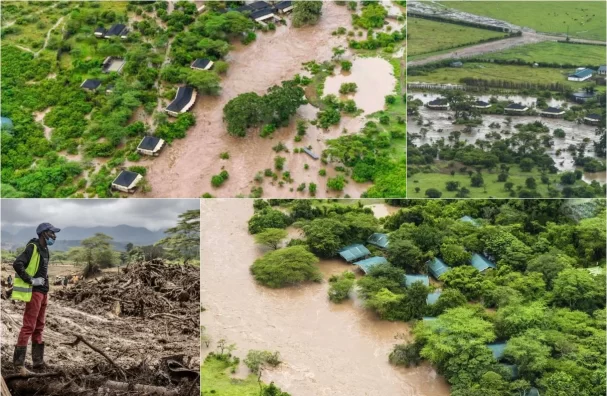
Over the past few months, Kenya has been grappling with an unprecedented deluge, resulting in widespread flooding, landslides, and infrastructural damage. The situation escalated dramatically on Wednesday when a river burst its banks within the renowned Maasai Mara National Reserve, submerging numerous tourist facilities.
The heavy downpours have taken a severe toll on the Maasai Mara, a world-famous safari destination known for hosting the annual wildebeest migration from the Serengeti in Tanzania. As the floodwaters rapidly engulfed over a dozen hotels, lodges, and camps, tourists found themselves trapped, prompting immediate evacuation efforts.
In response to the crisis, the Kenya Red Cross swiftly mobilized, rescuing more than 90 stranded individuals. The Narok County government deployed two helicopters to airlift tourists from the expansive conservation area, which had become increasingly inaccessible due to the rising waters.
“The situation was critical, with lodges and camps completely submerged. Our priority was to ensure the safety of the tourists and staff,” said a Red Cross spokesperson.
The freak floods in the Maasai Mara are just the latest in a series of weather-related disasters that have plagued Kenya since mid-March, when the rainy season commenced. Tragically, more than 170 lives have been lost across the nation due to flooding, landslides, and the destruction of infrastructure.
The Meteorological Department has warned that more rainfall is expected in the coming days, exacerbating the already dire situation.
Even Nairobi, the capital city, has not been spared from the onslaught of heavy rains. On Wednesday, three major roads were temporarily closed due to severe flooding, causing significant disruptions to daily life and transportation.
The Kenya Red Cross also rescued 11 individuals from a residential area in Kitengela, on the outskirts of Nairobi, after their homes were inundated overnight.
The impact of the relentless rains has been particularly devastating in the Mai Mahiu area, located in western Kenya. On Monday, a river burst through a clogged tunnel, triggering a catastrophic landslide that swept away houses and damaged roads.
The tragic incident has claimed the lives of 48 people, with over 80 others still missing. Search and rescue operations are ongoing, but locals report that the lack of adequate equipment is hampering efforts to dig through the debris.
President William Ruto has ordered the military to join the search, underscoring the gravity of the situation.
Compounding the crisis, water levels in two major hydroelectric dams are rising to “historic highs,” according to government officials. Authorities have urged residents living in flood-prone areas to evacuate or face forced relocation, as the risk of further flooding increases.
The flooding in the Maasai Mara has dealt a significant blow to Kenya’s vital tourism industry, which heavily relies on visitors drawn to the region’s unparalleled wildlife and natural beauty.
With the wildebeest migration season rapidly approaching, concerns are mounting about the potential long-term impact on the local economy and the livelihoods of those dependent on tourism.
As the devastating effects of the floods continue to unfold, experts are calling for increased preparedness and climate change mitigation measures to address the growing frequency and intensity of extreme weather events.
The Kenyan government, in collaboration with international organizations and local communities, must prioritize disaster response strategies, infrastructure reinforcement, and environmental conservation efforts to safeguard lives and protect the nation’s natural treasures.
